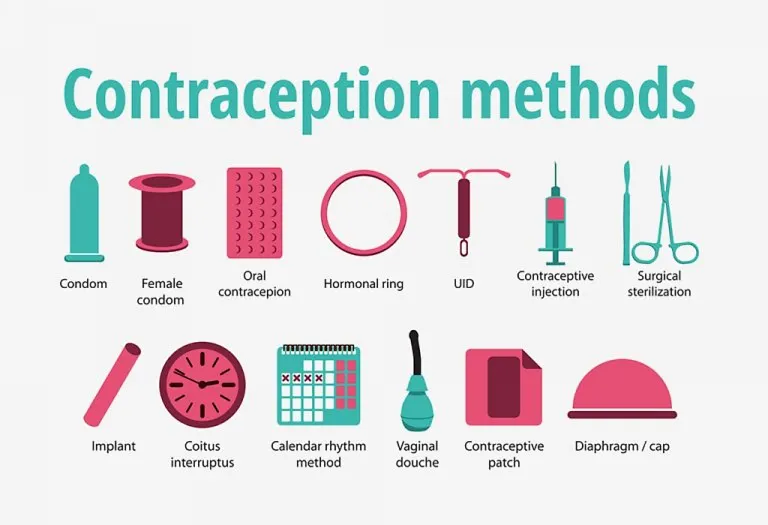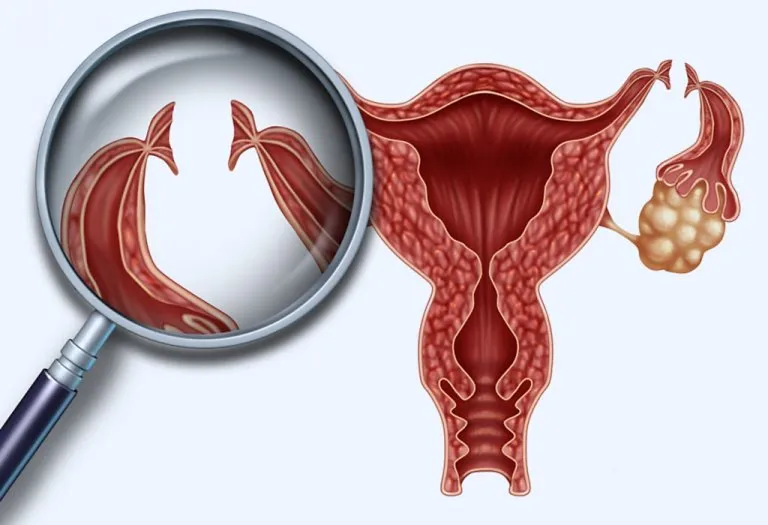Luteal Phase: Symptoms, Duration, and Its Role in Pregnancy

- What Is the Luteal Phase?
- Why Is the Luteal Phase Important for Pregnancy?
- How to Calculate the Luteal Phase of a Menstrual Cycle
- Body Changes in Luteal Phase
- How Do You Know That Your Luteal Phase Is Short?
- What Causes a Short Luteal Phase?
- How Can You Test Your Progesterone Level?
- How Can You Increase the Luteal Phase?
- What Is a Luteal Phase Defect?
- FAQs
A menstrual cycle consists of three phases, namely ovulatory, luteal, and follicular. Each phase of the menstrual cycle has its own importance in fertilising the ovum and making you pregnant. If you aren’t pregnant, it also sheds the unused endometrial lining at the termination of the cycle. The luteal phase occurs during the latter half of the menstrual cycle. It typically starts around day 15 in a standard 28-day cycle and concludes when menstruation begins. The luteal cycle readies the uterus for pregnancy by enhancing the thickness of the uterine lining. Any issues related to your luteal phase may impact both conception and the ability to maintain a pregnancy. This article discusses the luteal phase and its connection to pregnancy.
What Is the Luteal Phase?
As per the luteal phase definition, the period between ovulation and the beginning of the next menstrual cycle is called the luteal phase. The follicle gets converted to a corpus luteum during this phase. A corpus luteum is the cell structure that produces high amounts of progesterone and some oestrogen. These luteal phase hormones play an important role in pregnancy. The luteal menstrual phase prepares the uterus for pregnancy by thickening the uterine lining (1).
If you have a normal menstrual cycle of about 25 to 28 days, the luteal phase will last for about 12 to 14 days (2). If you have a menstrual cycle of less than 25 days, the luteal phase can be shorter.
Can you get pregnant during the luteal phase? Yes, you can. Since the luteal phase is after ovulation, you have a very real chance of getting pregnant.
Why Is the Luteal Phase Important for Pregnancy?
The luteal phase is the period between ovulation and menstruation. It aids in enhancing the lining of your uterus, promotes the development and attachment of a potentially fertilised egg, causes a minor rise in your overall body temperature, and increases the thickness of your cervical mucus to guard against bacterial growth or infections (3) (4). Therefore, the health and length of the luteal phase will speak to the regard of your fertility.
1. Impact of the Luteal Phase’s Length on Pregnancy
If your period of luteal phase is less than ten days, then you may find it hard to become pregnant. The reason behind this is that if your corpus luteum weakens and dies in 9 days, ceasing the luteal phase hormone production, then your uterus starts shedding its lining instantaneously, leaving no time for the fertilised ovum to move from the Fallopian tube to the ovary, and get implanted in the uterus lining.
If your luteal phase is short, you will not get pregnant even if the ovum gets fertilised, because you will get your period before the embryo can attach to the uterine lining.
2. Impact of the Luteal Phase’s Health on Pregnancy
Sometimes, even if the duration of the luteal phase is normal, your body may produce less amount of progesterone during this phase, which can be a problem. A sufficient quantity of progesterone is needed to ensure the healthy thickness of the uterus lining. A low amount of progesterone results in a lining that is not healthy enough to sustain a pregnancy.
Therefore, it is important to have a luteal phase that is of normal length and is healthy as well.
How to Calculate the Luteal Phase of a Menstrual Cycle
Here are some ways to calculate the length of your luteal phase:
- A hormone-specific blood test can determine the accurate length of your luteal phase.
- You can track your menstrual cycle for approximately 6 months, and observe the patterns of your phases of the menstrual cycle, to calculate an approximate length of the luteal phase.
- Basal Body Temperature (BBT) Charting: The BBT of your body increases during ovulation, and stays high until the onset of your upcoming period. Track the temperature from the start of the menstrual cycle, and observe the rise in BBT. The rise in body temperature is a solid confirmation that you are ovulating.
Formula to Calculate Ovulation Time During Luteal Phase
- Day of ovulation = length of menstrual cycle – length of luteal phase
Assume that for a menstruation cycle that lasts for 29 days, the luteal phase lasts up to 15 days. Assigning these values in the formula:
- Day of ovulation = 29
- 29 (length of menstrual cycle) – 15 (length of luteal phase)
- Day of ovulation = 14
It implies that the 14th day of the menstrual cycle is the day your ovulation occurs.
A prediction kit or calculator for ovulation can also be used to know the day of ovulation, and hence the luteal phase.
Body Changes in Luteal Phase

During the luteal phase, the upsurge in progesterone levels can result in the following body changes (5):
- Mood swings
- Food cravings
- Thickened and sticky cervical mucus (4)
- Tiredness
- Tender nipples and breasts
- Bloating
- Anxiety
- Fluid retention
These luteal phase symptoms are bound to happen, and do not lower your likelihood of getting pregnant.
Towards the end of the luteal phase, premenstrual syndrome (PMS) usually occur, such as bloating, weight gain, lower back pain, cramps, bowel changes, nausea, exhaustion, depressed mood, crying, mood swings, irritability, tender and swollen breasts (6).
How Do You Know That Your Luteal Phase Is Short?
You can know that your luteal phase is short by tracking your menstrual cycle. Count the number of days between ovulation and the onset of your next period, and this will give you an idea of the length of your luteal phase.
If your luteal phase lasts for 12 or more days, it is normal. But if your luteal phase lasts less than 10 days, you have low levels of progesterone. This means that your luteal phase is short.
What Causes a Short Luteal Phase?
A luteal phase less than nine days is called a short luteal phase (7). When your body doesn’t produce sufficient estrogen and progesterone, your luteal phase might end early. As per a study, women with a short luteal phase were more likely to have a history of smoking than those with a longer phase (8). The following reasons might be responsible for not producing enough progesterone:
- Thyroid disorders
- PCOS
- Obesity
- Excessive exercise
- Anorexia (and milder forms of restrictive eating)
- Stress
- Ageing
How Can You Test Your Progesterone Level?
The luteal phase progesterone levels are generally higher than in other phases of your menstrual cycle. Your progesterone levels should be tested when they are highest, i.e. in the middle of the luteal phase, which is on the 21st day of a normal 28-day menstrual cycle.
Of course, it is not given that all women have a typical 28-day menstrual cycle. If you have a 34-day menstrual cycle, with ovulation occurring around the 22nd day, then you cannot test your progesterone level on day 21, as the results might show a very low level of the hormone. But if you test it on the 28th day, your progesterone level may be normal.
Hence, if you want to know when you ovulate and the length of your luteal phase, tell your doctor about the right time to test your progesterone levels.
How Can You Increase the Luteal Phase?
Taking the following supplements might help to lengthen your luteal phase:
- Vitamin C – it increases fertility in some cases where women have short luteal phases.
- Progesterone supplementation or cream – Progesterone cream can increase your progesterone levels, but please consult your doctor before using this.
What Is a Luteal Phase Defect?
Luteal phase defect or luteal insufficiency is the deficient release of progesterone throughout the luteal phase. The insufficiency of progesterone will not thicken the uterus lining, which can result in improper embryo plantation. Hence, it reduces the chances of a pregnancy continuing. However, it is not yet confirmed if a luteal phase defect is a reason for infertility.
A luteal phase defect can lead to the following problems:
- Improper working of the corpus luteum results in lesser production of estradiol and progesterone.
- Inability of the uterus lining to react to normal levels of estradiol and progesterone.
1. Cause of Luteal Phase Defect
A luteal phase defect could happen due to the following reasons:
- Defect in the egg
- Breakdown of corpus luteum
- Un-ruptured follicle
- Thyroid disorders
- Over-exercise
- Anorexia
- Endometriosis
- Polycystic ovary syndrome
- Obesity
- Hyperprolactinemia
2. Symptoms of Luteal Phase Defect
The symptoms of a luteal phase defect are as follows:
- Miscarriages
- Spotting in between periods
- Menstrual cycles are way earlier than normal
3. Diagnosis of a Luteal Phase Defect
A luteal phase defect can be diagnosed by getting the following tests done:
- Blood tests
These tests check the level of:
- Progesterone helps in the thickening of the uterine lining.
- Follicle-stimulating hormone, which regulates ovarian functions.
- Luteinising hormone triggers ovulation.
- Ultrasound
It helps to find the thickness of the uterus lining. An ultrasound scan can help detect the functioning of the reproductive organs, i.e. the uterus, ovaries, cervix, and Fallopian tubes.
- Endometrial Biopsy
A small sample of your endometrial lining is procured and examined under a microscope to check its thickness. This should be done at least one or two days before the start of your period.
4. Treatment Options for Luteal Phase Defect
The treatment of a luteal phase defect depends on the main underlying causes.
- Human Chorionic Gonadotropin: It releases progesterone and triggers ovulation. During this process, the hCG level is given in a single dosage of 10,000 IU or two dosages of 5,000 IU, given once in 2 weeks to extend the luteal phase.
- Clomiphene Citrate: These are also called human menopausal gonadotropins. These help in stimulating the ovaries to produce more follicles, which release more eggs.
- Suppositories: Crinone, a vaginal gel, is used vaginally three times a day. The gel holds a progesterone dosage of 90 mg.
- Pill Treatment: Prometrium oral progesterone medicines are administered at a 200 mg dosage per day.
- Injections: Intramuscular progesterone is administered at a dose of 25 to 50 mg per day. The injection uses crystalline and odourless progesterone powder dissolved in sesame oil.
FAQs
1. Can the duration of the luteal phase change from one cycle to another?
Yes, the duration of the luteal phase can fluctuate. Although it generally lasts between 12 and 14 days, variables such as stress, hormonal fluctuations, or health issues can lead to minor variations.
2. Is it possible to conceive during the luteal phase of your menstrual cycle?
Conception occurs during the luteal phase of your menstrual cycle when the sperm meets the egg. It’s essential to understand that conception and fertility are not the same thing. While conception takes place in the luteal phase, your highest chances of getting pregnant (the most fertile days of your cycle) are in the follicular phase. If you attempt to conceive after ovulation, you only have a window of 12 to 24 hours for conception to take place. So, the likelihood of getting pregnant increases if you have intercourse within the five days leading up to ovulation, which falls in the follicular phase. Utilising an ovulation calendar can help you determine your ovulation timing (1).
3. What is the necessary length of a luteal phase to achieve pregnancy?
If your luteal phase is too short (fewer than 10 days post-ovulation), it may hinder your ability to conceive because your uterine lining may not have enough time to grow sufficiently to support a pregnancy. Nonetheless, every individual’s body is unique, and having a luteal phase shorter than the average does not automatically imply that you cannot conceive. It’s advisable to speak with a healthcare professional if you are trying to become pregnant (1).
4. What are the emotions you may experience during your luteal phase?
It is common to feel irritability, sadness, and anxiety during the luteal phase. Your mood might shift unpredictably between different feelings. Although ovulation can boost sexual desire, this may decline as progesterone levels rise, resulting in a reduced desire for the remainder of your luteal phase.
5. Why do I feel so fatigued during the luteal phase?
Research suggests that progesterone may contribute to increased fatigue. Given that your progesterone levels are higher during this phase, it is likely that you will experience tiredness.
6. Are cravings natural in the luteal phase?
Yes, a craving for sweet and fatty foods is common during the follicular luteal phase. You may be drawn towards sugary items, like baked goods, chips, chocolates, and candies.
The luteal phase, which lasts around 14 days, is the time when the female body prepares the womb for the fertilised ovum. You should have a luteal phase of both sufficient length and health to sustain a pregnancy. You can consult a doctor for a mid-luteal phase progesterone test to check if everything is normal.
References/Resources:
1. Cleveland Clinic – Luteal Phase
2. PubMed Central – Progesterone and the Luteal Phase
4. NIH – Physiology, Menstrual Cycle
6. NIH – Premenstrual Syndrome
7. ASRM – DIAGNOSIS AND TREATMENT OF LUTEAL PHASE DEFICIENCY: A COMMITTEE OPINION (2021)
8. PubMed Central – A prospective evaluation of luteal phase length and natural fertility
Also Read:
LH Surge
Calendar Based Methods of Contraception
Can You Get Pregnant on Your Period?
How To Calculate Safe Period To Avoid Pregnancy?
Was This Article Helpful?
Parenting is a huge responsibility, for you as a caregiver, but also for us as a parenting content platform. We understand that and take our responsibility of creating credible content seriously. FirstCry Parenting articles are written and published only after extensive research using factually sound references to deliver quality content that is accurate, validated by experts, and completely reliable. To understand how we go about creating content that is credible, read our editorial policy here.
























